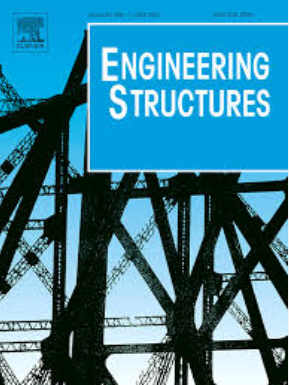超高性能聚甲醛纤维加固混凝土中嵌入的玻璃纤维增强塑料条的粘结行为研究
IF 5.6
1区 工程技术
Q1 ENGINEERING, CIVIL
引用次数: 0
摘要
玻璃纤维增强聚合物(GFRP)棒材与聚甲醛(POM)纤维增强超高性能混凝土(UHPC)相结合,可形成具有卓越使用性能和超常耐久性的结构系统。粘结是影响使用 GFRP 棒材和 POM 纤维增强超高性能混凝土结构使用性能的关键因素。因此,本文通过直接拉拔试验研究了 GFRP 钢筋和 POM 纤维增强 UHPC 之间的粘结行为。试验变量包括钢筋类型、POM 纤维的体积分数、预埋长度、钢筋直径、混凝土保护层厚度和混凝土抗压强度。讨论了这些试验变量对 GFRP 钢筋与 POM 纤维增强 UHPC 的破坏模式、粘结应力-滑移曲线和粘结强度的影响。试验结果表明,POM 纤维的体积分数和钢筋直径对粘结强度几乎没有影响。粘结强度最初随着混凝土覆盖层厚度的增加而增加,当混凝土覆盖层厚度达到钢筋直径的 3.35 倍时,粘结强度趋于稳定。此外,还提出了 GFRP 加固 UHPC 试样粘结强度的预测模型,并利用其他文献中的测试数据进行了验证。建立了一个通用的粘结-滑移构成模型,以准确描述 GFRP 钢筋和 UHPC 的粘结-滑移关系。本文章由计算机程序翻译,如有差异,请以英文原文为准。
Investigation on bond behavior of GFRP bar embedded in ultra-high performance polyoxymethylene fiber reinforced concrete
The combination of glass fiber reinforced polymer (GFRP) bars and polyoxymethylene (POM) fiber reinforced ultra-high performance concrete (UHPC) can create a structural system with excellent service performance and exceptional durability. Bond is a critical factor affecting the service performance of structures constructed using GFRP bars and POM fiber reinforced UHPC. Therefore, this paper investigates the bond behavior between GFRP bar and POM fiber reinforced UHPC by using a direct pull-out test. The test variables were reinforcement type, volume fraction of POM fiber, embedment length, diameter of reinforcement, thickness of concrete cover, and compressive strength of concrete. The effects of these test variables on the failure mode, bond stress-slip curve and bond strength of GFRP bar with POM fiber reinforced UHPC were discussed. The test results revealed that the volume fraction of POM fibers and the reinforcement diameter have barely effect on the bond strength. The bond strength initially increases with increasing concrete cover thickness, and then plateaus after the concrete cover thickness reaches 3.35 times the reinforcement diameter. Furthermore, a predictive model for bond strength of GFRP reinforced UHPC specimens was proposed and validated using test data from other literature. A general bond-slip constitutive model was established to accurately describe the bond-slip relationship of GFRP bar and UHPC.
求助全文
通过发布文献求助,成功后即可免费获取论文全文。
去求助
来源期刊

Engineering Structures
工程技术-工程:土木
CiteScore
10.20
自引率
14.50%
发文量
1385
审稿时长
67 days
期刊介绍:
Engineering Structures provides a forum for a broad blend of scientific and technical papers to reflect the evolving needs of the structural engineering and structural mechanics communities. Particularly welcome are contributions dealing with applications of structural engineering and mechanics principles in all areas of technology. The journal aspires to a broad and integrated coverage of the effects of dynamic loadings and of the modelling techniques whereby the structural response to these loadings may be computed.
The scope of Engineering Structures encompasses, but is not restricted to, the following areas: infrastructure engineering; earthquake engineering; structure-fluid-soil interaction; wind engineering; fire engineering; blast engineering; structural reliability/stability; life assessment/integrity; structural health monitoring; multi-hazard engineering; structural dynamics; optimization; expert systems; experimental modelling; performance-based design; multiscale analysis; value engineering.
Topics of interest include: tall buildings; innovative structures; environmentally responsive structures; bridges; stadiums; commercial and public buildings; transmission towers; television and telecommunication masts; foldable structures; cooling towers; plates and shells; suspension structures; protective structures; smart structures; nuclear reactors; dams; pressure vessels; pipelines; tunnels.
Engineering Structures also publishes review articles, short communications and discussions, book reviews, and a diary on international events related to any aspect of structural engineering.
 求助内容:
求助内容: 应助结果提醒方式:
应助结果提醒方式:


